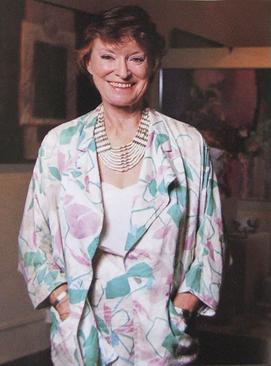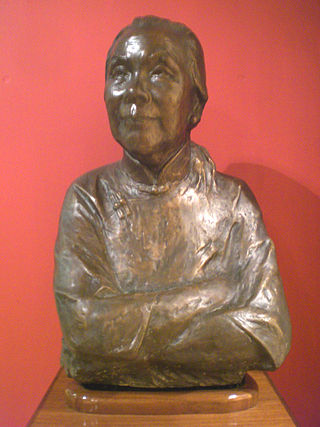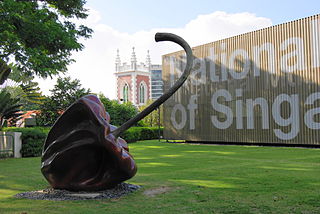Related Research Articles

Gao Xingjian is a Chinese émigré and later French naturalized novelist, playwright, critic, painter, photographer, film director, and translator who in 2000 was awarded the Nobel Prize in Literature "for an oeuvre of universal validity, bitter insights and linguistic ingenuity." He is also a noted translator, screenwriter, stage director, and a celebrated painter.

Fann Woon Fong, known professionally as Fann Wong, is a Singaporean actress, singer, businesswoman and model. She has been referred to as one of MediaCorp's Ah Jie for being one of the most successful actresses from Singapore.
The Institute of Contemporary Arts (ICA) Singapore is the curatorial division of LASALLE College of the Arts, dedicated to supporting innovative and emerging creative practices. Focusing on art and design from the present, it provides an active site for contemporary culture in Singapore. It comprises five galleries that span a total of 1,500 square metres, one of the largest spaces devoted to contemporary art in Singapore. It engages local and international audiences in critical viewing and discussion through a diverse programme of exhibitions, projects, publications and events.
Lee Wen was a Singapore-based performance artist who shaped the development of performance art in Asia. He worked on the notion of identity, ethnicity, freedom, and the individual's relationship to communities and the environment. Lee's most iconic work is his performance series titled The Journey of aYellow Man, which started as a critique of racial and ethnic identities in 1992 and has evolved into a meditation on freedom, humility, and religious practices over more than a decade. Painting his own body with bright yellow poster paint, he expresses an exaggerated symbol of his ethnic identity as a citizen of Singapore. He was also active in artist-run initiatives, especially as part of The Artists Village (TAV) in Singapore, the performance artist collective Black Market International, as well as the festivals Future of Imagination and Rooted in the Ephemeral Speak (R.I.T.E.S.). On 3 March 2019, he died due to a lung infection, at the age of 61.

The National Gallery Singapore, often known exonymously as the National Gallery, is a public institution and national museum dedicated to art and culture located in the Civic District of Singapore. It oversees the world's largest public collection of Singaporean and regional art of the Eastern world, specifically of Southeast Asia, with a collection of more than 9,000 items.

Della Butcher was an art gallery owner and an avid patron of Singapore art, noted for her lifetime of work supporting Singaporean artists and making it an international name.

Georgette Liying Chendana Chen, commonly known as Georgette Chen, was a Singaporean painter and one of the pioneers of modern Singaporean art as well as the Nanyang style of art in the region.

Han Sai Por is a Singaporean sculptor. A graduate of the Nanyang Academy of Fine Arts (NAFA), East Ham College of Art, Wolverhampton College of Art, and Lincoln University, New Zealand, she worked as a teacher and later as a part-time lecturer at NAFA, the LASALLE-SIA College of the Arts, and the National Institute of Education, Nanyang Technological University, before becoming a full-time artist in 1997.

The Nanyang style of painting, also known as Nanyang art or the Nanyang school, was a modern art movement and painting tradition initially practised by migrant Chinese painters in Singapore from the late-1940s to 1960s. As immigrant artists taken by the novelty of tropical landscapes, the Nanyang artists' works characteristically depicted Southeast Asian subject matter such as tropical fruit, kampung scenes, and batik fabric while drawing upon a synthesis of Western watercolor and oil painting techniques with Chinese ink traditions.

Fang Zhaoling, also known as Lydia Fong, was a Chinese painter and calligrapher.

Ong Schan Tchow alias Yung Len Kwui was born in the ethnically Hokkien city in the eastern part of Longyan prefecture, Southern Fujian Province, China. He was well known for Chinese Ink wash painting and colour paintings of flowers, landscapes, animals, people, still life and Calligraphy. He was regarded as one of the first few batches of Chinese scholars and artists to study in Paris and one of the few artists who integrated both traditional Chinese and Western art techniques. During the Second Sino-Japanese War, he became renowned as a patriot artist when he exhibited extensively in China, Hong Kong and later in South East Asia to raise funds solely for the war relief effort and for the countless Chinese civilian victims in China, Malaysia and Singapore.
Pearl Lam is a Hong Kong-born gallerist, patron, and curator. She is recognized as a leading authority on Asian contemporary art and design. In 2021, Tatler recognized her as one of Asia’s most Influential people. She is regarded as one of the most instantly recognizable gallerists globally due to her unique personal style.

Dawn Ng is a visual artist from Singapore who works across a diverse breadth of mediums, motives and scale ranging from text, illustration, collage, light, sculpture to large scale installations. Her work primarily deals with time, memory, and the ephemeral.

Sun Chan is a self-taught artist who is known for his unique Chinese character motifs. Born in Lima, Peru, in 1932 to an overseas Chinese family, he was brought back to Fóshān, Guǎngdōng China to study the Chinese language at the age of five. At this time Chan first became fascinated with Chinese characters. He has always loved calligraphy and painting but was unfortunately deprived of an education after the second grade due to the break out of the Pacific War. He went through considerable hardship in the subsequent years and later moved to Hong Kong, where he worked his way from the ground up and established himself as a successful entrepreneur.

NTU Centre for Contemporary Art Singapore is a national research centre affiliated with Nanyang Technological University (NTU).

Juliana Yasin was a Singaporean contemporary artist and curator whose practice spanned painting, installation, video, and performance art. Her works examined notions of identity, subjectivity, and community practices. Pedagogy and research further complemented her artistic practice, with Juliana having taught fine art at Kolej Bandar Utama in Kuala Lumpur and worked as a Singapore-based researcher for the Asia Art Archive, Hong Kong.
Constance Sheares is a Singaporean arts administrator, curator, and writer. Sheares helped establish the National Museum Art Gallery in 1976, curating its inaugural exhibition and other major exhibitions. Through exhibitions, publications, and acquisitions initiated at the Museum, Sheares helped to shape the basis of art institutions and art historical discourse in Singapore.
Erika Tan is a London-based Singaporean contemporary artist and curator whose research-led practice emerges from her interests in anthropology and the moving image. Her recent research examines the postcolonial and transnational, working with archival artefacts, exhibition histories, received narratives, contested heritage, subjugated voices, and the movement of ideas, people and objects. She is a lecturer at the Central Saint Martins, University of the Arts London.

Kumari Nahappan is a Malaysian-born Singaporean contemporary artist best known for her large-scale public sculptures that often depict natural subjects such as fruit, seeds, and spices. Aside from sculpture and public art, Nahappan's interdisciplinary practice also spans installation and abstract painting.

Chen Cheng Mei, also known as Tan Seah Boey, was a Singaporean artist known for her pioneering work as the woman behind the Ten Men Art Group. A loose collective of Singapore-based artists, the Ten Men Art Group made work based on their travels around Southeast Asia in the 1960s, and around China and India in the 1970s.
References
- 1 2 3 4 5 6 7 Huang, Lijie (9 June 2014). "Artists' champion: Helina Chan wants to make local artists more 'visible'". The Straits Times . Singapore. Retrieved 26 October 2024.
- 1 2 Yusof, Helmi (30 April 2015). "Did you say 'difficult' art? She will sell it". The Business Times . Singapore. Retrieved 26 October 2024.
- ↑ Ng, Shing Yi (2 March 2005). "Sowing the seeds of art appreciation". today . Singapore. Retrieved 26 October 2024.
- ↑ "Helina Chan: Balancing the arts". The Jakarta Post . 23 April 2006. ProQuest 288428442 . Retrieved 27 October 2024.
- 1 2 Chia, Adeline (24 July 2011). "Accidental dealer: They are glamorous, colourful and powerful players in the local art gallery scene: Meet the Tiger Ladies of Singapore art". The Straits Times . ProQuest 878774120 . Retrieved 27 October 2024.
- ↑ Yusof, Helmi (8 March 2013). "Sizeable showcase of local art". The Business Times . ProQuest 1315189531 . Retrieved 27 October 2024.
- ↑ Yusof, Helmi (23 October 2014). "Lupus-struck gallerist starts research fund". The Business Times . Singapore. Retrieved 26 October 2024.
- ↑ "Sickly, but strong-willed". The Straits Times . 22 January 2015. ProQuest 1647364664 . Retrieved 27 October 2024.